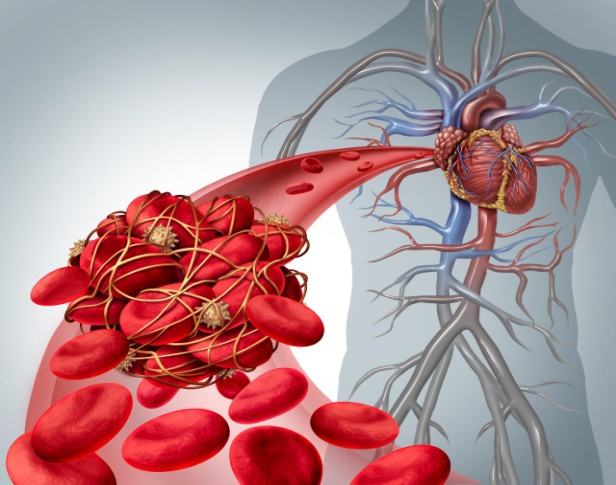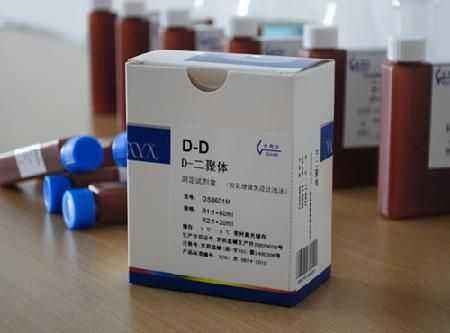SCI论文(www.lunwensci.com):
摘要:D-二聚体是纤溶酶介导的交联纤维蛋白降解的特异性产物,其作为血栓形成和继发性纤溶亢进的标志物,在临床上得到广泛应用。近年来研究发现D-二聚体不仅可用于血栓性疾病的诊断,而且在恶性肿瘤、心脑血管疾病、严重感染等领域有新的拓展,对这类疾病的早期诊断、临床分期和预后评估起着重要作用。
关键词:D-二聚体;临床疾病;诊断;预后
本文引用格式:孙京华,卢发强.D-二聚体在临床应用中的新进展[J].世界最新医学信息文摘,2019,19(82):98-99.
New Progress of D-dimer in Clinical Application
SUN Jing-hua,LU Fa-qiang*
(Department of Clinical Laboratory,Affiliated ZhangShan Hospital of DaLian University,Liaoning Dalian)
ABSTRACT:D-dimer is a specific product of plasminase-mediated cross-linked fibrin degradation,and it has been widely used in clinical practice as a marker of thrombosis and secondary fibrinolysis.In recent years,studies have found that d-dimer can not only be used in the diagnosis of thrombotic diseases,but also has new development in the fields of malignant tumors,cardiovascular and cerebrovascular diseases,serious infections and other fields,which plays an important role in the early diagnosis,clinical stage and prognosis evaluation of such diseases.
KEY WORDS:D-dimer;Clinical diseases;Diagnosis;Prognosis
0引言
D-二聚体是纤溶酶裂解纤维蛋白时经活化的凝血因子XIII(FXIIIa)交联产生的特异性产物。在凝血系统激活期间,凝血酶催化纤维蛋白原形成纤维蛋白,FXIIIa使纤维蛋白形成交联纤维蛋白;纤溶过程启动时,纤溶酶再将交联纤维蛋白降解成不同大小的片段,即纤维蛋白降解产物(FDPs);D-二聚体是FDPs之一,由两个共价结合的纤维蛋白D结构组成[1,2]。D-二聚体用于深静脉血栓形成、肺栓塞、DIC等疾病的诊断和监测已得到广泛认可。近年来,随着人们研究的不断深入,D-二聚体在临床中潜在的应用价值被发现。本文就D-二聚体在临床应用中的新进展作一综述。
1D-二聚体与静脉血栓栓塞症
静脉血栓栓塞(VTE)是一种多因素疾病,包括深静脉血栓形成(DVT)和肺栓塞(PE),发病率、致残率和死亡率高[3]。D-二聚体的升高与VTE首次发生、复发和患者死亡率密切相关[4]。一项对808名疑似PE患者的前瞻性研究[5]表明D-二聚体的总体阴性预测值为99.8%,与计算机断层扫描肺血管造影(CTPA)相当,证明它可作为一项独立指标安全地排除肺栓塞。D-二聚体对VTE的排除具有良好的敏感性,但特异性较差,联合临床风险评估可进一步提高对VTE的预测价值[6]。近年来研究发现[7,8],D-二聚体水平在不同年龄和性别有所差异,随着年龄的增长而升高,女性略高于男性,并且在妊娠期间会显著增加。为了降低高龄人群的假阳性结果,美国医师学会(American College of Physicians)[9]已批准在评估50岁以上人群是否存在肺栓塞时,使用年龄调整的D-二聚体(年龄×10 ng/mL),而不是传统的D-二聚体临界值(500ng/mL)。Takach等人[10]的研究表明,与年龄调整策略相比,通过临床概率调整的D-二聚体临界值更有助于提高静脉血栓栓塞的诊断准确性。
2D-二聚体与DIC
DIC是一种复杂的获得性综合征,其特征在于促凝物质进入循环并导致中小血管内血栓形成,表现为全身的凝血系统被激活,以及血小板和凝血因子的持续消耗,从而引起继发性纤溶亢进,导致全身广泛出血[11]。由于凝血系统的激活继发性引起纤维蛋白溶解,血浆D-二聚体水平可在30分钟内升高,并且随着DIC进展,D-二聚体水平的增加更显著[12]。国际血栓和止血学会(ISTH)[13]认可了D-二聚体检测在DIC诊断中的作用,是早期诊断DIC的良好指标,但其诊断DIC的最佳截止值仍有待进一步研究。
3D-二聚体与恶性肿瘤
越来越多的证据表明肿瘤诱导的内外源性凝血系统和纤维蛋白溶解级联反应的激活与肿瘤血管生长,肿瘤细胞侵袭及转移有内在联系[14]。D-二聚体对消化系统肿瘤的预后有较好的预测作用,其中与结直肠癌的相关性最高,高水平的D-二聚体与结直肠癌患者的预后不良相关,相较癌胚抗原(CEA)能更好地预测患者疾病进展和存活率[15,16]。D-二聚体水平的检测对肺癌的诊断、分期和预后判断有非常重要的临床意义[17,18]。Chen等[19]研究发现,病情处于好转或稳定期的小细胞肺癌患者血浆D-二聚体水平显著低于病情恶化的患者。在一项研究[20]中,通过评估D-二聚体水平与乳腺癌的关系,发现乳腺癌患者的血浆D-二聚体水平与肿瘤体积、分期、淋巴血管浸润及淋巴结受累呈正相关。而另一项研究[21]结果表明D-二聚体水平与乳腺癌肿瘤大小无关(P=0.71),但与淋巴结受累程度(P=0.001)和淋巴血管浸润程度(P=0.002)显著相关,其中与受累淋巴结数量相关性最强。因此,D-二聚体水平升高是乳腺癌淋巴血管浸润、淋巴结受累和肿瘤转移的重要标志,可作为乳腺癌的良好预后标志物。
4D-二聚体与心脑血管疾病
4.1D-二聚体与冠状动脉粥样硬化性心血管疾病
心血管疾病(CVD)的发病率和死亡率在全球一直呈上升趋势。急性冠状动脉综合征(ACS)通常由动脉粥样硬化斑块破裂导致的血栓形成引起,因此,有人提出[22]D-二聚体与冠状动脉疾病(CAD)的发病机制有关。Gong等人[23]在一项对2209例血管造影证实CAD患者的研究中,通过多变量线性回归分析发现血浆D-二聚体水平与冠状动脉狭窄的严重程度和CAD患者的预后显著相关。有研究[24]对D-二聚体与CAD患者斑块特征和氧化特异性表位血浆生物标志物的关系进行了探讨,发现D-二聚体水平与斑块坏死、钙化和血浆脂蛋白(a)水平呈显著正相关,为D-二聚体与心血管事件的相关性提供了病理生理学依据,表明血浆D-二聚体可作为预测稳定CAD患者未来心血管事件的标志物。
4.2D-二聚体与心房颤动
心房颤动(AF)是最常见的持续性心律失常,由于血流动力学紊乱导致血栓栓塞风险增加约五倍[25]。一项多中心研究[26]结合临床数据进行综合评估,发现在使用导管消融治疗AF前血浆D-二聚体的测定有助于心房内血栓的排除诊断。结合D-二聚体水平有助于对AF的患者进行危险分层,为易患左心房血栓的患者提供抗凝治疗的进一步证据[27]。有文献报道[28],通过对269名AF患者进行随访,评估患者D-二聚体水平与随后发生心血管事件的关系,发现D-二聚体水平与不良事件风险呈正相关,可用于预测AF患者的预后。
4.3D-二聚体与急性主动脉夹层
急性主动脉夹层(AAD)是最危险的心血管疾病之一,其患者死亡率非常高。Li等[29]研究发现AAD患者症状出现后24小时内,D-二聚体水平有助于区分AAD与其他原因引起的胸痛,其水平<0.5g/mL有助于AAD的排除诊断,灵敏度为94.0%,特异性为56.8%,阳性预测值为42.6%,阴性预测值为96.6%。Dong等[30]研究发现AAD患者的D-二聚体水平明显高于心肌梗死、肺栓塞和腹主动脉瘤患者以及健康人群,在病例组和健康组的分析中,D-二聚体的特异性为96.4%,ROC曲线下的AUC为0.863,证明D-二聚体的检测对于AAD的诊断价值良好。有研究表明[31],虽然D-二聚体对AAD的诊断具有高灵敏度和低特异性,但单独的D-二聚体阴性结果不能排除致命AAD的患者,建议将主动脉夹层检测风险评分(ADD-RS)与D-二聚体水平相结合进行评估。
4.4D-二聚体与脑梗死
脑梗死是临床上常见的脑血管疾病,由局部缺血和脑组织坏死诱发,其发病率、死亡率和复发率均较高,通常会导致中枢神经系统的严重损害。血栓纤维蛋白溶解失衡是影响急性脑梗死预后的主要原因之一,动态监测血浆中D-二聚体水平有助于识别患者再梗死或出血的风险[32]。Wei等[33]通过纳入300例急性脑梗死患者探讨血浆D-二聚体水平与脑梗死之间的关系,发现血浆D-二聚体水平与脑梗死患者的预后呈负相关(r=-0.41;P=0.013),其中心源性栓塞患者的血浆D-二聚体水平最高,神经功能缺损最严重,预后最差;而腔隙性梗死患者的D-二聚体水平最低,预后最好。与先前的研究结果一致,Rui等人[34]通过对124例急性脑梗死患者的临床研究发现D-二聚体水平可反映急性脑梗死患者的病情和预后,较高水平的D-二聚体表明患者的预后较差。
5D-二聚体与脓毒血症
脓毒血症是世界范围内一个重要的公共卫生问题,每年约有3100万病例,死亡率高达17%[35]。在脓毒血症患者中,炎症导致凝血活化,凝血活化促进纤维蛋白形成,内皮损伤和炎症导致血管内纤维蛋白沉积,炎症与凝血激活的相互作用可导致微血栓形成,从而导致多器官衰竭[36]。有研究显示,正常的D-二聚体水平可排除器官功能障碍或死亡等不良预后,且在更高的截止水平下,可将脓毒血症患者进行风险分层[37]。脓毒血症的早期阶段,D-二聚体显著升高,与疾病的严重程度和患者死亡率增加独立相关[38],成为脓毒血症的重要预后因素。
6结语和展望
D-二聚体一直被视为血栓形成和纤溶亢进的良好的非侵入性标志物。为了进一步提高D-二聚体诊断疾病的灵敏性和特异性,其根据年龄和性别调整的诊断策略仍有争议。目前研究表明D-二聚体与恶性肿瘤、心脑血管疾病、严重感染等疾病密切相关,对于疾病病情的监测起着重要的作用。下一步可扩大样本量,开展大规模的临床研究,进一步探讨D-二聚体在临床疾病中的应用价值,寻找其用于疾病诊断的最佳临界值,从而指导疾病危险分层,并为临床治疗提供科学的指导。
参考文献
[1]Weitz J I,Fredenburgh J C,Eikelboom J W.A Test in Context:D-Dimer[J].J Am Coll Cardiol,2017,70(19):2411-2420.
[2]Riley R S,Gilbert A R,Dalton J B,et al.Widely Used Types and Clinical Applications of D-Dimer Assay[J].Lab Med,2016,47(2):90-102.
[3]Silvia R,Patrizia F,Massimo Z F,et al.Predicting VTE in Cancer Patients:Candidate Biomarkers and Risk Assessment Models[J].Cancers,2019,11(1):E95.
[4]Rim H,Popma C J,Ander C,et al.D-Dimer elevation and adverse outcomes[J].J Thromb Thrombolysis,2015,39(1):55-59.
[5]Bates S M,Takach L S,Douketis J D,et al.Rapid Quantitative D-dimer to Exclude Pulmonary Embolism:A Prospective Cohort Management Study[J].J Thromb Haemost,2016,14(3):504-509.
[6]Yang F,Yumei L,Si C,et al.The combination of Caprini risk assessment scale and thrombotic biomarkers to evaluate the risk of venous thromboembolism in critically ill patients[J].Medicine,2018,97(47):e13232.
[7]Haase C,Joergensen M,Ellervik C,et al.Age-and sex-dependent reference intervals for D-dimer:Evidence for a marked increase by age[J].Thromb Res,2013,132(6):676-680.
[8]García I G,Cañadas P P,Uriarte J M,et al.D-dimer during pregnancy:establishing trimester-specific reference intervals[J].Scand J Clin Lab Invest,2018,78(6):439-442.
[9]Raja A S,Greenberg J O,Amir Q,et al.Evaluation of Patients With Suspected Acute Pulmonary Embolism:Best Practice Advice From the Clinical Guidelines Committee of the American College of Physicians[J].Ann Intern Med,2015,163(9):701-711.
[10]Takach L S,Julian J A,Linkins L A,et al.Comparison of clinical probability-adjusted D-dimer and age-adjusted D-dimer interpretation to exclude venous thromboembolism[J].Thromb Haemost,2017,117(10):1937-1943.
[11]Levi M.Pathogenesis and diagnosis of disseminated intravascular coagulation[J].International journal of laboratory hematology,2018,40(Suppl 1):15-20.
[12]Li W J,Sha M,Ma W,et al.Efficacy evaluation of D-dimer and modified criteria in overt and nonovert disseminated intravascular coagulation diagnosis[J].Int J Lab Hematol,2016,38(2):151-159.
[13]Suzuki K,Wada H,Imai H,et al.A re-evaluation of the D-dimer cut-off value for making a diagnosis according to the ISTH overt-DIC diagnostic criteria:communication from the SSC of the ISTH[J].J Thromb Haemost,2018,16(7):1442-1444.
[14]Dongmei D,Zhe W,Yao C,et al.D-dimer:not just an indicator of venous thrombosis but a predictor of asymptomatic hematogenous metastasis in gastric cancer patients[J].Plos One,2014,9(7):e101125.
[15]Yan L,Liu Z,Qiu Y,et al.Clinical significance of plasma D-dimer and fibrinogen in digestive cancer:A systematic review and meta-analysis[J].Eur J Surg Oncol,2018,44(10):1494-1503.
[16]Zhu L,Liu B,Zhao Y,et al.High levels of D-dimer correlated with disease status and poor prognosis of inoperable metastatic colorectal cancer patients treated with bevacizumab[J].J Cancer Res Ther,2014,10 Suppl(8):246-251.
[17]Minfeng Z,Yi D,Feng G,et al.Correlations of coagulation indexes and inflammatory changes with the prognosis of lung cancer complicated with thromboembolic disease[J].J BUON,2019,24(2):585-590.
[18]Shanshan F,Guanfei Z,Guangyu A.High pretreatment plasma D-dimer levels are associated with shorter overall survival in patients with small cell lung cancer[J].J Int Med Res,2019,47(1):215-224.
[19]Chen Y,Yu H,Wu C,et al.Prognostic value of plasma D-dimer levels in patients with small-cell lung cancer[J].Biomed Pharmacother,2016,81:210-217.
[20]Ghadhban B R.Plasma d-dimer level correlated with advanced breast carcinoma in female patients[J].Ann Med Surg,2018,36:75-78.
[21]Harish S,Raxith S R,Sarath C P.Role of Plasma D-Dimer Levels in Breast Cancer Patients and Its Correlation with Clinical and Histopathological Stage[J].Indian J Surg Oncol,2018,9(3):307-311.
[22]Peter L.Mechanisms of acute coronary syndromes and their implications for therapy[J].N Engl J Med,2013,368(21):2004-2013.
[23]Gong P,Yang S H,Li S,et al.Plasma d-Dimer as a Useful Marker Predicts Severity of Atherosclerotic Lesion and Short-Term Outcome in Patients With Coronary Artery Disease[J].Clin Appl Thromb Hemost,2016,22(7):633-640.
[24]Kothari H,Nguyen A T,Yang X,et al.Association of D-dimer with Plaque Characteristics and Plasma Biomarkers of Oxidation-Specific Epitopes in Stable Subjects with Coronary Artery Disease[J].J Cardiovasc Transl Res,2018,11(3):221-229.
[25]Siegbahn A,Oldgren J,Andersson U,et al.D-dimer and factor VIIa in atrial fibrillation-prognostic values for cardiovascular events and effects of anticoagulation therapy.A RE-LY substudy[J].Thromb Haemost,2016,115(5):921-930.
[26]Antoine M,Pierre I,Frédéric T,et al.Exclusion of Intra-Atrial Thrombus Diagnosis Using D-Dimer Assay Before Catheter Ablation of Atrial Fibrillation[J].JACC Clin Electrophysiol,2019,5(2):223-230.
[27]Wan H,Wu S,Yang Y,et al.Plasma fibrin D-dimer and the risk of left atrial thrombus:A systematic review and meta-analysis[J].Plos One,2017,12(2):e0172272.
[28]Tsuneaki S,Motoaki S,Satoshi O.Evidence that D-dimer levels predict subsequent thromboembolic and cardiovascular events in patients with atrial fibrillation during oral anticoagulant therapy[J].J Am Coll Cardiol,2010,55(20):2225-2231.
[29]Li W,Huang B,Tian L,et al.Admission D-dimer testing for differentiating acute aortic dissection from other causes of acute chest pain[J].Arch Med Sci,2017,13(3):591-596.
[30]Dong J,Duan X,Feng R,et al.Diagnostic implication of fibrin degradation products and D-dimer in aortic dissection[J].Sci Rep,2017,7:43957.
[31]Baez A A,Cochon L.Improved Rule-Out Diagnostic Gain with a Combined Aortic Dissection Detection Risk Score and D-Dimer Bayesian Decision Support Scheme[J].J Crit Care,2017,37(4):56-59.
[32]Meng R,Ji X B.Dynamical levels of plasma F(1+2)and D-dimer in patients with acute cerebral infarction during intravenous urokinase thrombolysis[J].Neurol Res,2009,31(4):367-370.
[33]Wei Y,Zheng-Hong S.The relationship between plasma D-dimer levels and outcome of Chinese acute ischemic stroke patients in different stroke subtypes[J].J Neural Transm,2014,121(4):409-413.
[34]Rui W,Yamin W,Junfang T.Levels of Plasma N-terminal Pro-brain Natriuretic Peptide and D-dimer on the Prognosis of Patients with Acute Cerebral Infarction[J].Pak J Med Sci,2018,34(4):855-858.
[35]Fleischmann C,Scherag A,Adhikari N K,et al.Assessment of Global Incidence and Mortality of Hospital-treated Sepsis.Current Estimates and Limitations[J].Am J Respir Crit Care Med,2016,193(3):259-272.
[36]Marcel L,Marcus S,Tom V D P.Sepsis and thrombosis[J].Semin Thromb Hemost,2013,39(5):559-566.
[37]Goebel P J,Williams J B,Gerhardt R T.A Pilot Study of the Performance Characteristics of the D-dimer in Presumed Sepsis[J].West J Emerg Med,2010,11(2):173-179.
[38]Francesca I,Maria G A,Betti G,et al.Prognostic value of sepsis-induced coagulation abnormalities:an early assessment in the emergency department[J].Intern Emerg Med,2019,14(3)459-466.
关注SCI论文创作发表,寻求SCI论文修改润色、SCI论文代发表等服务支撑,请锁定SCI论文网! 文章出自SCI论文网转载请注明出处:https://www.lunwensci.com/yixuelunwen/14852.html


